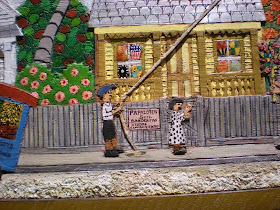Folk artists have a knack for being in the right place at the right time, and creating images that appeal to the audience of the moment. Time and time again in these pages I have written about folk artists who find and meet the market demand for inexpensive, bold, colorful, and meaningful images. You could say that folk artists are opportunistic in the manner in which they pursue their trade. And although their products may be lightly regarded in their own time, they acquire great value over time as we come to see how resourceful and beautiful these works really are, and how well they shed light on historical periods long past.
This isn’t only true of American folk art, but also of folk art around the world. I was reminded of this on a recent visit to the Minneapolis Institute of Arts. This encyclopedic art museum, with holdings from antiquity to the present and from all parts of the globe, had two modest sized galleries that intrigued me. One was a gallery of American folk art: more on that in a future post. The other was a complete surprise.
As I was wandering through the byzantine galleries of the museum, I happened to stroll through the Asian wing, admiring the many large and intricate hanging scroll paintings and huge folding screens with scenes painted on them. I don’t know much about Asian art (the collection was primarily Chinese and Japanese) but I do enjoy the aesthetic of form and pattern, so it was a pleasant walk-through.
Then I took a detour into a gallery that was a bit off the beaten path. The room was full of Japanese folk paintings from the 17th, 18th, and 19th centuries, and the similarities of circumstance with American folk art were striking. Apparently there was a major roadway (called the Tokaido roadway) that linked Kyoto with the military stronghold of Edo (now Tokyo) as early as the 1600s. On this highway was a town called Otsu, where travelers often stopped for a respite on their journey.
Sometime in the early part of the century, enterprising artists started creating inexpensive and small hanging scroll paintings to sell to these wayfarers. None of these artists are known by name, but the works they made and sold are vintage folk art: simple, direct, bold, colorful, sometimes humorous, and memorable. Some of the works feature pagodas, other tell funny stories about everything from Gods and Demons to daily life at the time. It was a tradition, and a market, that lasted for three centuries.
These works are called Otsu-e, or pictures of Otsu (e means “picture” in Japanese). As the demand for these works grew, artists started innovating in production, just like their American counterparts. They used stencils to speed the imaging of particular forms, much the way the American mural painter Rufus Porter advised Americans to do the same in New England the 1840s. And they sought out well-traveled byways like the Florida Highwaymen on the 20th century.
The works on display at the Minneapolis Institute included (in order of their appearance here) one of the Pagoda paintings (from the late 19th century), and several others that depicted the God of Thunder trying to retrieve the drum he accidentally dropped into the ocean (from the late 18th-mid 19th century), the God of Agriculture humorously trying to shave the elongated forehead of the God of Longevity and Wisdom (early 18th century), a cat offering a mouse a hot pepper to make him drink sake and become inebriated, and a falconer (both early 18th century).
I’m a firm believer that any museum that claims to be encyclopedic must have folk art represented in its galleries. These humble works of Otsu-e were the only glimpse into the daily life of ordinary people in the entire Asian wing, as far as I could tell. The folk art of any culture has a collective power that speaks for the vast masses for whom art was a welcome respite on a long and dusty highway.









































